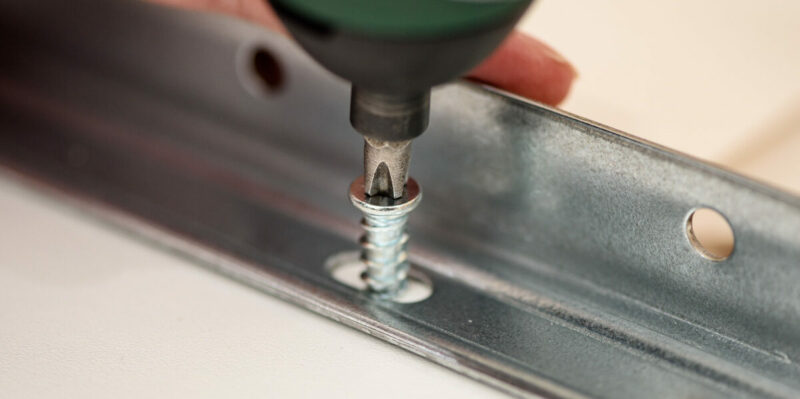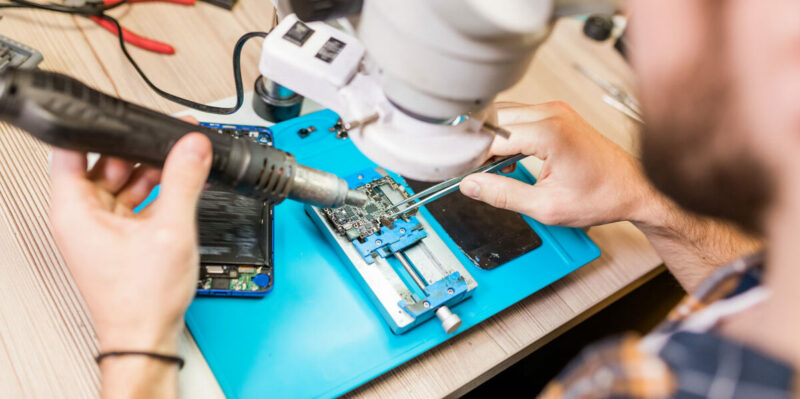Multimeters are essential tools for anyone who works with electricity. They let you measure voltage, current, resistance, and frequently have even more testing capabilities. Whether it is for home DIY purposes, building or repairing electronics or automotive work, a multimeter gives you insight in what is going on and is an essential part in keeping you safe.
Previously you would need a collection of tools to measure all these different units, but nowadays this can all be done with a single device. Instead of buying a separate voltmeter, ohmmeter and ammeter, you can now simply buy a multimeter and you are all set.
With many different multimeters available on the market today, it can be hard to figure out which is the best multimeter for you. Not only do they come with different features, but the different types of multimeters are suited for different purposes as well..
To help you choose the best multimeter for your needs, I have gone over the currently available models and narrowed them down to the ones that are best. No matter if you are a DIYer, HVAC professional or electrician, you will find a top pick for each. I have also included a buyer’s guide that explains what to look for when buying a multimeter, so you can be certain that you are making the right choice.
Let’s dive in!
| Best Multimeter | Summary | Price | Best Offer |
|---|---|---|---|
| Fluke 115 Compact True-RMS Digital Multimeter | Best overall | $165 | |
| Fluke 87V MAX True-RMS Digital Multimeter | Best high-end | $444 | |
| Klein Tools MM400 Multimeter | Best on a budget | $45 | |
| Fluke 116 HVAC Multimeter | Best for HVAC professionals | $159 | |
| HASAGEI HZT102A Multimeter | Largest display | $32 | |
| Fluke 323 True-RMS Clamp Meter | Best clamp meter | $132 | |
| Simpson 260-8 Analog Multimeter | Best analog | $300 | |
| Gardner Bender GMT-319 Multimeter | Best budget analog | $28 | |
| Fluke 233 Remote Display Multimeter | Best with remote display | $286 |
What is a Multimeter?
A multimeter is an electronic measuring instrument that can measure a variety of electrical elements. A standard multimeter gives you information about voltage, resistance and current, whereas advanced models might also measure capacitance, conductance, frequency, decibels and more.
What is a Multimeter Used for?
Multimeters are primarily used as a diagnostic tool. The voltage, resistance and current measurements are particularly useful when working on electrical systems. This information can be used to tell if everything is working correctly, or if a circuit is behaving abnormally. If there is some kind of problem, the multimeter can help figuring out what might be the cause of the issue.
A multimeter is also essential in keeping you safe. Many electric devices have the potential to injure and even kill you. Often, the first step in working on an electrical system is to make sure that everything has powered down properly, and there is no live current on wires or other components. This is especially important when dealing with alternating current (AC), which typically has higher voltages and is more dangerous than direct current (DC).
Practical Use Cases
You might be wondering in what situations it is useful to have a multimeter. Basically, any time you do any electrical work you benefit from having one. Here are a couple of scenarios in which a multimeter is helpful, if not essential:
- Checking the voltage of batteries
- Testing for live current on wires
- Building electronics
- Working on HVAC systems
- Testing your car battery
- Repairing electronic devices
- Checking for bad circuit breakers
Top Multimeters in 2024
The Fluke 115 has everything you would expect from the best all-round multimeter. It has exceptional build quality, is easy to use, accurate and is loaded with features. It is especially ideal for automotive work, but also a great choice for DIYers and electricians.
Its light weight and compact build make thihttps://amzn.to/3nBWSLAs multimeter easy to store and carry wherever you want to go, while the backlit screen lets you use the tool in low lighting locations without problems. Aside from covering all the basic tests, it also lets you check for continuity, frequency and capacitance.
With this durable and all-round excellent multimeter, you can cover your basic electrical testing needs for many years to come.
Standout Features
- Large backlit screen
- Min/Max/Average to record signal fluctuations
- Continuity testing
Technical Details |
|
|---|---|
| CAT rating | CAT III 600 V |
| True-RMS | Yes |
| Display resolution | 600 count |
| Max. voltage | 600 V AC/DC |
| Max. current | 10A AC/DC current measurement 20A overload |
| Max. resistance | 40 MΩ |
| Max. capacitance | 10,000 μF |
| Other measurement capabilities | Continuity/diode test |
What We Like
- Reliable
- Easy to read screen
- True-RMS
Could Be Better
- Does not measure mA
- Low contrast LCD
The Fluke 87V MAX is one of the most popular multimeters under professional electricians and technicians, and for a good reason. It is fully packed with features, and there really isn’t much that this meter does not have.
A standout feature of this multimeter is its durability. With its IP67 rating, it is completely water- and dust proof. You can use it in dirty environments or even drop it in the mud. Simply rinse it off at the end of the day and you are good to go the next morning.
As expected from Fluke, the device has True-RMS, so you can get accurate readings from both linear and non-linear loads. It is rated for CAT III 1000 V/CAT IV 600 V and will let you work on basically anything without having to worry about exceeding the tools limitations.
Standout Features
- Extremely durable
- True-RMS
- Works in extreme heat and cold
- Temperature probe
Technical Details |
|
|---|---|
| CAT rating | CAT III 1000 V, CAT IV 600 V |
| True-RMS | Yes |
| Display resolution | 6000/20000 count |
| Voltage | DC: Maximum resolution: 0.1 mV to 1000 V AC: Maximum resolution: 0.1 mV to 1000 V |
| Current | AC: Maximum resolution: 0.1 µA to 10 A |
| Resistance | Maximum resolution: 0.1 Ω to 50 MΩ |
| Capacitance | 0.01 nF to 9999 µF |
| Frequency | 0.5 Hz to 199.99 kHz |
| Temperature | -328 to 1994°F (-200 to 1090°C) |
What We Like
- Accurate and precise
- Lifetime warranty
- Waterproof, dustproof and drop-resistant
Could Be Better
- No manual included
The Klein MM400 is a great multimeter for anyone on a budget. It isn’t the absolute cheapest option out there, but unlike its competition, it isn’t likely to break a couple years after you buy it.
If you are looking for a multimeter for your basic home repairs, say working on outlets, switches or circuit breakers, this is a good option. It won’t be as accurate as a Fluke multimeter, but that is not something you need for these tasks.
The MM400 has auto-ranging functionality, so you don’t need to fiddle around to find the right range while testing. In terms of the type of measurements you can do, you will find that there are a lot for a multimeter at this price point. Temperature, capacitance, frequency, duty-cycle, continuity, it’s all there.
With its versatile feature-set and CAT III 600V safety rating, the Klein MM400 is an excellent multimeter for both residential and business environments.
Standout Features
- Auto-ranging function
- Relatively accurate
- Temperature measurement
Technical Details |
|
|---|---|
| CAT rating | CAT III 600V |
| True-RMS | No |
| Display resolution | 4000 count |
| Max. voltage | 600V AC/DC |
| Max. current | 10A AC/DC |
| Max. resistance | 40 MΩ |
| Max capacitance | 200µF |
| Temperature range | 0° - 1000°F (-18° - 538°C) |
| Other measurement capabilities | Frequency, duty-cycle, and test diodes and continuity |
What We Like
- Lots of measuring capabilities
- Comes with thermocouple
- Great value
Could Be Better
- No true-RMS
- Limited capacitance testing
HVAC (heating, venting and air conditioning) professionals have different multimeter needs than electricians and other technicians, and for that reason there are multimeters that specifically meet their requirements. The Fluke 116 is one of these tools, and as it happens, one of the best ones as well.
You might notice that just like the other multimeters for professionals in this article, I recommend a Fluke-branded tool. This is not by accident, as Fluke is one of the few brands that can give you the reliability, safety and accuracy that you need as someone who makes their living with and around electrical devices. The Fluke 116 is no exception to that.
In terms of specific HVAC functionality, this multimeter has a built-in thermometer, so you can take accurate temperature measurements on the spot. It also has an option to measure microamps. This is not an option that you see on every multimeter, and it is a great feature for testing flame sensors. Additionally, this device has a low input impedance (Low Z), so you will have less problems with false readings due to ghost voltage.
Of course, it also comes with the standard measurements (resistance, continuity, frequency and capacitance) you would expect from a multimeter, making it a complete tool for anyone who works with HVAC equipment.
Standout Features
- Built-in thermometer
- Tests microamps to check flame sensors
- Helps prevent false readings due to ghost voltage
Technical Details |
|
|---|---|
| CAT rating | CAT III 600V |
| True-RMS | Yes |
| Display resolution | 6000 count |
| Max. voltage | 600V AC/DC |
| Max. current | 600 μA AC/DC |
| Max. resistance | 40 MΩ |
| Max. capacitance | 10,000 μF |
| Max. temperature | 400 °C |
What We Like
- Low input impedance
- Backlit screen
- True-RMS
Could Be Better
- Only measures low-current applications
- Slow auto-ranging
Not all of us see as well as the next person, but that should not stop one from being able to use a multimeter. So for people who have trouble reading the digits on a typical DMM screen, I have included the best multimeter with large screen that I could find: the HASAGEI HZT102A.
With its 2.4″ screen, it is one of the easiest to read multimeter screens available. Not just because of its size, but also because of its high contrast and always-on function. So whether it is day or night, you can always get a clear reading of your measurements.
In terms of testing, it has a wide range of measurement options. From your standard voltage, current and resistance options to duty cycle, capacitance and non-contact voltage sensing. The latter allows you to find live wires without having to touch them.
Additionally, the HZT102A comes with an included thermocouple for temperature measurement. Not bad for the price!
Standout Features
- Large, high-contrast display
- Non-contact voltage testing
- Automatic AC/DC detection
Technical Details |
|
|---|---|
| CAT rating | CAT II 1000V, CAT III 600V |
| True-RMS | Yes |
| Display resolution | 6000 count |
| Max. voltage | DC 1000 V AC 750 V |
| Max. current | DC 10A |
| Max. resistance | 60 MΩ |
| Max. capacitance | 9.999mF |
| Temperature range | -4 to 1832 ℉ |
| Other measurement capabilities | Frequency, duty cycle |
What We Like
- Easy to read screen
- Great for the price
- Included thermocouple
- True-RMS
Could Be Better
- Low quality test leads
- Inaccurate low Ohm readings
Clamp meters are ideal for when you want to measure alternating currents without disconnecting or de-energizing the circuit first. Unlike digital multimeters (DMMs), that can generally only measure up to 10 A of current, you can use clamp meters to measure hundreds, and sometimes even thousands of amps safely.
One of the best clamp meters currently available is the Fluke 323. It allows you to measure up to 400 A of current in conductors of up to 30 millimeters in diameter, without interrupting the circuit. And because of its true-RMS calculation, you can do this accurately for both linear and non-linear loads.
Aside from measuring current, you can also use the device to measure voltage and resistance using the included probe leads. Altogether, this is a great tool for servicing, installing or maintaining a wide range of electrical systems.
Be aware however, you can’t use the Fluke 323 to measure DC current. For that, you will need a clamp meter with a hall effect sensor, like the Fluke I30S.
Standout Features
- Clear display
- Ergonomic design
- True-RMS
Technical Details |
|
|---|---|
| CAT rating | CAT IV 300V/CAT III 600 V |
| True-RMS | Yes |
| Max. voltage | 600 V AC/DC |
| Max. current | 400 A AC |
| Max. resistance | Up to 4 kΩ with continuity detection |
What We Like
- Accurate
- Fits well in tight spaces
- True-RMS
Could Be Better
- Does not measure DC current
- Impractical lead connection ports
For some, nothing beats the quick response and reliability of an analog multimeter. These are not its only benefits. A good quality analog meter can also really help when dealing with fluctuating signals. These signals are often averaged on DMMs, and are hard to identify on a bar graph because of its typically low refresh rate.
The Simpson 260-8 12388 is one of the options that gives you everything you might look for in an analog meter. Its interface is designed for easy use, with two knobs to select functions and ranges.
The main dial is large and printed in three colors. This makes it a lot easier to get accurate readings. On top of that, the scale is mirrored. So inaccurate readings caused by parallax error are not something you need to worry about.
Its build quality is robust and solid, but despite that, the device is portable enough to take with you in the field. You will be hard-pressed to find a better analog meter on the market right now.
Standout Features
- Easy to use interface
- Mirrored scale to prevent parallax error
- Recessed safety jacks
Technical Details |
|
|---|---|
| Max. voltage | 1000V AC/DC |
| Max. current | AC: 250 A DC: 10 A |
| Max. resistance | 20 MΩ |
| Decibel range | -20 to +50dB |
What We Like
- Portable
- Good accuracy
- Solid construction
Could Be Better
- Pricy
For those who are looking to buy a cheaper analog multimeter, there is the Gardner Bender GMT-319. Despite its low price, it still gives you plenty of features. While it doesn’t have the same build quality and accuracy of a high-end analog meter, the GMT-319 is still good enough for most applications.
Aside from giving you the choice to measure voltage, current and resistance, this meter also has a voltage meter specifically for batteries (1.5 V and 9 V). So you can go through your collection of batteries and quickly see which ones need to be replaced, and which still have a good charge.
Standout Features
- Clear, color-coded gauge
- Continuity tester with buzzer
- Replaceable fuse
Technical Details |
|
|---|---|
| CAT rating | CAT II 1000V |
| Max. voltage | 1000V AC/DC |
| Max. current | DC: 500 mA |
| Max. resistance | 10 MΩ |
| Decibel range | -8db to +62db on AC voltage ranges |
What We Like
- Easy to read display
- Reliable
- Battery test mode (1.5V/9V)
Could Be Better
- Manual needs to be downloaded
The Fluke 233 is a multimeter that sets itself apart from the competition with a nifty feature: a detachable screen. This makes it an excellent option for automotive technicians, who often have to do measurements in hard to reach areas.
With this meter, it is simply a matter of connecting the test leads, detaching the screen and finding a comfortable spot to view and record the test data. If you are working on the undercarriage of a car and need to stay there, you can simply use the magnetic back of the screen to attach it to a convenient point instead.
Aside from the detachable screen, it comes with all features you would expect from a quality multimeter. Not just auto-ranging voltage, amperage and resistance measurements, but also continuity checking and temperature measuring.
Needless to say, the Fluke 233 comes with the measurement accuracy that you can expect from Fluke. And specifically for automotive technicians there is the 233/A kit that comes with several extra useful automotive accessories.
Standout Features
- Detachable magnetic display
- Built-in thermometer
- Min/Max and average recording
Technical Details |
|
|---|---|
| CAT rating | CAT IV 600 V , CAT III 1000 V |
| True-RMS | Yes |
| Display resolution | 6000 count |
| Max. voltage | 1000 V AC/DC |
| Max. current | 10A AC/DC |
| Resistance range | 0.1 Ω to 40 MΩ |
| Capacitance range | 1 nF to 9999 μF |
| Frequency range | 5 Hz to 50 kHz |
| Temperature range | -40°C to +400°C |
What We Like
- Display can be detached and used up to 33'/10m away
- True-RMS
- Available with NIST certificate
Could Be Better
- Drains battery power when not in use
Buyer’s Guide – What to Pay Attention to When Buying a Multimeter
When buying a multimeter, just like when buying any other tool, it is important to keep in mind what you will be using it for. No matter what you are looking for, the best option for you will be different from that of other people.
If you just want a simple multimeter for DIY work around the house, you won’t need the highest-end model with all bells and whistles. If you are a professional, on the other hand, you need something with more than basic functionality. Not only that, but the multimeter needs to be extra durable and built to last.
In short, choose the multimeter you are going to buy based on what you are going to use it for most of the time. And keep in mind that because you will be working with electricity, buying a multimeter from a reputable brand (e.g. Fluke, Klein Tools, Agilent, Amprobe) is going to be safer than purchasing the cheapest option you can find.
Before going further into detail on multimeters, it might be useful to go over some of the terminology that you will encounter in this buyer’s guide.
- Voltage. Voltage is a measure of the potential difference between two points in a circuit. Simply put, it is the driving force that pushes electricity to flow. You can see this as the pressure of water in a pipe.
- Volts. The unit in which voltage is measured.
- Current. The rate of flow of electric charge.
- Amperes. The unit in which current is measured.
- Direct current. Abbreviated as DC. This is current that only flows in a single direction. You can find it in low voltage applications, like batteries or at the output side of your computer power supply.
- Alternating current. Abbreviated as AC. The direction of this current gets constantly switched back and forth. This usually happens 60 or 50 times a second and is why AC power typically has a frequency of 50 or 60 Hz.
- Frequency. How often an event, like alternating current, cycles per second.
- Hertz. Abbreviated as Hz. This is the unit in which frequency is typically measured.
- Resistance. The ability of material to resist the flow of current.
- Ohms. The unit in which resistance is measured.
- Live wire. An electrical wire through which there is a flow of electrical current. Don’t touch this!
- Open circuit. A circuit which is not fully connected, and in which there is no current flow.
- Closed circuit. A complete electric circuit through which electrons can flow.
- Continuity testing. The process of checking an electric circuit to see if it is a closed circuit and current can flow. This is usually done with a multimeter.
Functionality
Multimeters are multipurpose devices, and as such, come with a variety of features. Some of those are possible with any multimeter, but others are only available with specialized meters.
Generally, the more features a multimeter has, the more expensive it is. But, more functions does not automatically mean that the tool is harder to use. Switching between functions is often as simple as twisting the main rotary switch. This is why even the more advanced multimeters can be used by people who have not had extensive training.
Basic Measurement Functions
At a minimum, you want to make sure that the multimeter that you buy can measure voltage, resistance and current. These are all standard functions and you will find these in basically any digital multimeter nowadays.
Aside from this, you want to be able to measure both AC and DC voltage, so that is something you should pay attention to. You don’t want to get a separate device just so you can check both battery voltage (DC) and whether the wires in your house are live (AC).
Advanced Measurement Functions
Besides measuring the ‘big three’ units, advanced digital multimeters can measure even more. This additional testing functionality comes in very handy during specialized applications, like during HVAC installation or when troubleshooting electronic circuits.
Examples of other things that multimeters can test for are:
- Temperature. To measure temperature, multimeters typically use a temperature sensor called a thermocouple. These are typically placed on electrical devices to check their operating temperature.
- Frequency. Aside from the frequency itself, advanced multimeters might also check the current and voltage within a certain frequency range.
- Continuity. You can use this to test for any broken wires or loose connections in a circuit. In this mode, the multimeter will typically give you an audible beep when the points between the probes form a closed circuit.
- Transistor testing
- Capacitance
- RPM
- Decibels
Features
Multimeters can come with a variety of features that make using the device easier and more efficient. These features typically aren’t essential, but once you make use of them, you will be glad that you have them.
Quality Display
A large, high-contrast display is a useful addition to any multimeter. It helps you read the display faster, and you are less likely to make any errors while doing so.
Aside from the size and contrast of the screen, a backlight option is also great to have. You want to be able to see the screen in dimly lit environments.
Some multimeters, like the Fluke 233, even come with a detachable screen, which is practical if you can’t access the multimeter each time to check a measurement. This comes especially in handy during automotive repair and maintenance work.
Hold Function
The hold function prevents a multimeter from removing the current data on the screen. If you want to make note of a specific measurement, it can be tricky to memorize all digits. Instead, simply press the hold button during the measurement and write down the full value afterwards, at your own pace.
Auto-Hold Function
The auto-hold function is even better than the hold function. Rather than pressing a button, the auto-hold feature takes the measurement automatically when a reading becomes stable and keeps it on the display.
This function is significantly more powerful than the hold feature, because you don’t need to keep your eye on the multimeter, or even need to touch it. Most multimeters with an auto-hold function beep to notify you when the measurement is taken, so you will know when you are done.
Auto Ranging vs Manual Ranging
Multimeters come either with an auto-range function, or you have to set the range of the measurement manually using the rotary switch.
Manual Ranging
Manual ranging needs to be done by hand and is time-consuming. When you want to measure something, like a voltage, the first step would be to estimate the approximate range it falls in, and set the multimeter dial accordingly.
Assuming that you picked the right range, you can then test the voltage and read the value from the screen. If the measured voltage falls outside of the range you selected, you won’t be able to get a readout. You’ll need to re-adjust the range setting before trying again.
Needless to say, this process is a bit of a hassle. Especially when you need to take measurements of multiple components that fall in different measurement ranges.
Auto-Range
A multimeter with auto-range function is a lot easier to use. Instead of selecting the range manually, the meter will do all the work for you. It automatically goes over the range options until it has found the right one.
Because this takes some internal logic on the side of the device, you only find the auto-range function on digital multimeters. Analog multimeters are too simple and straightforward for this feature.
Auto-ranging is often preferred, because it saves a significant amount of time. The only thing you need to do is select the test you want to do, and you are ready to go.
Multimeter Safety
When working with electricity, safety should always be your main concern. With regard to a multimeter, it is essential that the voltages and currents that you will be testing do not exceed the capabilities of the tool.
To make figuring this out a bit easier, there are standardized measurement categories that indicate what kind of circuits a measuring tool, like a multimeter, can be used for. The categories rank from CAT I to CAT IV, with CAT I being the lowest and CAT IV the highest category of safety.
- CAT I – This is for measurements performed on circuits that are not directly connected to mains power. For example, circuits powered by regulated low-voltage sources (batteries), signal levels, and limited-energy parts of equipment.
- CAT II – This category refers to the electricity that comes from the power outlets in your home. If your multimeter has a rating of this category (or higher), you can use it to test circuitry in household appliances, portable tools and other devices that are powered using wall outlets.
- CAT III – Category III is for measurements on hard-wired equipment used in building installation. Examples are circuit breakers, distribution boards, bus-bars, junction boxes, and so on.
- CAT IV – Multimeters with a CAT IV specification can be used for the heavy duty stuff, like measuring circuits at the utility level. Here you can think about electricity meters, ripple control units and primary overcurrent protection devices.
If you require a multimeter of this category, you really do not need me to explain its applications to you.
The differences in safety come from a different hardware design. The multimeters in higher categories come with more safety features. For example, the circuit board will have better input protection and isolation slots that prevent electricity from arcing over.
On the multimeter leads themselves, you might find better insulation or wider flanges that keep your hand from slipping. Or shrouds over the banana plugs that prevent accidental touching of live wires.
Which Multimeter Safety Category Do You Need for Home Use?
A CAT III multimeter is the best option for home use. CAT II would work for most stuff, but if you ever need to do anything around the circuit breaker or distribution board, you need a CAT III multimeter.
Most good digital multimeters are rated at least CAT III nowadays, and there isn’t much reason to go with a lower safety rating.
Digital vs Analog Multimeters
One of the biggest questions you might ask yourself when buying a multimeter, is whether you should go with an analog or a digital one. These two types of multimeters each come with their own strengths and weaknesses, and it can be hard to choose between them if you are not sure what their differences are.
Analog Multimeters
Analog multimeters are characterized by their dial indicator. It uses a needle that swings over a fixed scale to indicate measurements. You can compare it to a car speedometer.
This type of readout has as an advantage that it is more easily readable in bright sunlight, when the numbers on a digital display can be hard to distinguish.
Another benefit of analog multimeters is that they respond a lot quicker than their digital counterparts. If you need to test a lot of wires in a short time, this lack of delay will make quite a difference. Similarly, if you are working with voltage transients, you need to have a multimeter that responds fast enough to detect them. An analog multimeter can do so.
Both of these are reasons why some electricians prefer analog multimeters over digital ones.
In general however, digital displays are prefered over analog dials. Reading a measurement from the dial needle is less precise, because you need to interpret the position of the needle yourself based on its position between the markings on the dial.
In addition, analog multimeters are limited in the number of different tests they can do. They are typically restricted to only measuring volts, ohms and amps.
Analog multimeters are also more sensitive to shocks and vibration. When exposed to either of these, the needle and coil can go out of calibration, or worse, stop working altogether. A protective rubber case will help absorb some of the impacts, but is not foolproof.
Digital Multimeters
Digital multimeters (DMMs) show their readouts on a digital display, instead of on a dial. Digital displays are not only better to read in low-light situations, but also provide a significantly higher accuracy and resolution, often up to 3.5 or 4.5 digits (more on this later).
DMMs also provide you with more measurement options than analog multimeters do. Aside from voltage, current and resistance, you can use them to measure frequency, capacitance, temperature and more.
Some of the features listed above, like the auto-ranging and (auto-)hold functions, can only be found on digital multimeters.
DMMs have a higher input impedance than analog multimeters, which is a useful property to have when it comes to measuring voltage accurately. Most analog multimeters have a low input impedance, which can affect the operation of a circuit and in turn create an inaccurate reading. This is because analog multimeters need to draw a current from the circuit to move the needle on the dial.
In terms of reliability, DMMs are superior as well. With less moving parts, there is less that is likely to break when the multimeter is exposed to vibrations and/or shock.
So Which is Best, an Analog or a Digital Multimeter?
With all the benefits listed above, you can probably see that digital multimeters are nearly always the preferred option. Unless you have specific needs that are only offered by analog multimeters, like a fast response time, a digital multimeter is the one you should go for.
Resolution
An important aspect of a multimeter is its resolution. This is a measure of the device’s sensitivity. A multimeter with a high resolution can detect very small changes in voltage, amperage, and so on.
For DMMs, the resolution is indicated by the number of digits that the screen can display. Typical multimeters come with a 3.5 or 4.5 digit resolution, but high-precision ones can go up to 6.5 or even more digits.
You might wonder where the .5 digit comes from. This is the leading digit, which can often only be a 0 or a 1. Full digits, on the other hand, can display from 0 to 9. So the maximum value that a 4.5 digit multimeter can display would be 19999.
An alternate way of specifying the resolution of a DMM is in counts. For example, a 20000-count multimeter can display values from 0 to 19999, and is essentially the same as a 4.5 digit multimeter.
The resolution of analog multimeters is a bit more complicated. It is dependent on the width of the needle, the accuracy of the dial scale and zero calibration, amongst others.
If you are looking for a multimeter for home use and home repair, you won’t need a high resolution. A device with 3.5 digit resolution will be sufficient.
Accuracy
No matter how much you spend, you won’t get a multimeter that gives you perfect readings. Even the best multimeter has some amount of error in its measurements. The accuracy of a multimeter refers to its largest allowed error.
Accuracy is expressed with the ‘±’ symbol, followed by a percentage. For example, if you use a multimeter with a ±1% accuracy to measure 10 V, it can give you a reading from 9.9 V to 10.1 V.
Sometimes, the accuracy has a number of digits, or counts, included. For example, reading 10 V with an accuracy of ±(1%+1) can give you a reading from 9.8 V to 10.2 V.
For your typical home use, like checking if certain wires are live, or making sure that AC voltage from the wall falls in the right range, you won’t need a high accuracy. But if you need to calibrate sensitive equipment, like that of a car or industrial machinery, you need a digital multimeter with a higher accuracy.
True-RMS vs Average-Responding
Not all multimeters measure alternating current (AC) or AC voltage the same way. Some models use true-RMS, whereas others are average-responding. These two methods can give different results depending on what type of waveform is being measured, so it is important to keep their difference in mind.
Non-sinusoidal waves: Waves with distorted, irregular patterns. For example: squares, triangles, sawtooth, and any other ragged or angular waves.
True-RMS multimeters use the root mean square of any AC waveform to calculate its equivalent direct current (DC) value. This gives you the DC equivalent of any AC wave shape.
Average-responding multimeters use averaging formulas. Averaging formulas are accurate when it comes to measuring pure sinusoidal waves, but when it comes to non-sinusoidal waves, they can introduce significant errors.
True-RMS multimeters are the preferred option, because they accurately measure both sinusoidal and non-sinusoidal AC waveforms.
That said, unless you know for sure that you will be dealing with non-sinusoidal waves, or with power lines that have unknown AC characteristics, you will be just fine with an average-responding multimeter.
Some applications in which you can find non-sinusoidal waves are electronics ballasts, computers, HVAC equipment, variable-speed motor drives and any other environment where current appears in short pulses instead of a smooth sine wave.
Input Impedance
The input impedance of a multimeter refers to the impedance value between the test leads, when the multimeter is set to measure voltage. Its symbol is Z, and input impedance is categorized in either Low Z (2 to 100 KΩ) or High Z (1 to 10 MΩ).
When measuring voltage, the multimeter is connected in parallel to the circuit. In order to minimize the effect of the meter on the circuit, it needs to have as high of an impedance as possible. That way, a minimal amount of current passes through it, and it won’t disturb the operation of the circuit as much.
A low impedance is also useful, but only when measuring current. This is when the meter is connected in series. A low impedance ensures that that branch of the circuit keeps behaving in the same way, because it does not create strong voltage drops or changes in current draw.
Digital multimeters typically come with a high impedance. This is particularly useful when working with sensitive electronics, like computers, phones and other gadgets. Influencing the circuit performance in these devices can have disastrous results.
Analog multimeters, especially the older ones, come with a low input impedance. When using these, you should avoid working on sensitive electronics.
Build Quality
A sturdy, high-quality multimeter is a tool that will last you a very long time. Going with a low-quality off-brand model might save you some money in the short term, but you will be looking for a replacement in no-time.
Features you can look for to ensure durability are bumper corners or a casing, which will dampen vibrations and impacts. Another indicator of a quality device is silicon insulated test leads. On cheaper multimeters these are often insulated with PVC and wear down a lot faster.
Accessories
To help you get the best out of your multimeter, you might want to buy one that comes with extra accessories.
The most important accessory, and the one you will be using most often, is the probes. You usually get a set of standard probes included with the multimeter, but to expand your testing capabilities it helps to have probes with different tips.
Alligator clips, for example, let you attach the probes to terminals so that you don’t have to keep them in place. But you can also find miniature (hook) clips, spade plugs and even more. These you can also find in an aftermarket kit, so they don’t necessarily need to be included with the multimeter itself.
Another useful addition is a magnetic case. This lets you attach the multimeter to any ferrous metal, and allows you to accurately read the display while keeping your hands free for testing.
Conclusion
Multimeters are essential tools when working with electricity. No matter if you are a homeowner that needs to check batteries, light bulbs and fuses, or if you are an electrician or HVAC technician that needs to use a multimeter every day. Unless you never get your hands dirty, there will come moments where you need to measure voltage, current or resistance.
There are many features that you need to think about when deciding on which multimeter to buy. The question whether you should buy an analog or digital multimeter should be answered first, as this will make the biggest difference in the product you end up with. Most of the time, a digital model is the best option.
As for what the best all-round multimeter is, my pick for this would be the Fluke 115. It is the perfect multimeter for both hobbyists and electricians, with great testing capabilities, excellent warranty and reliability all in one compact package without breaking the bank.




















